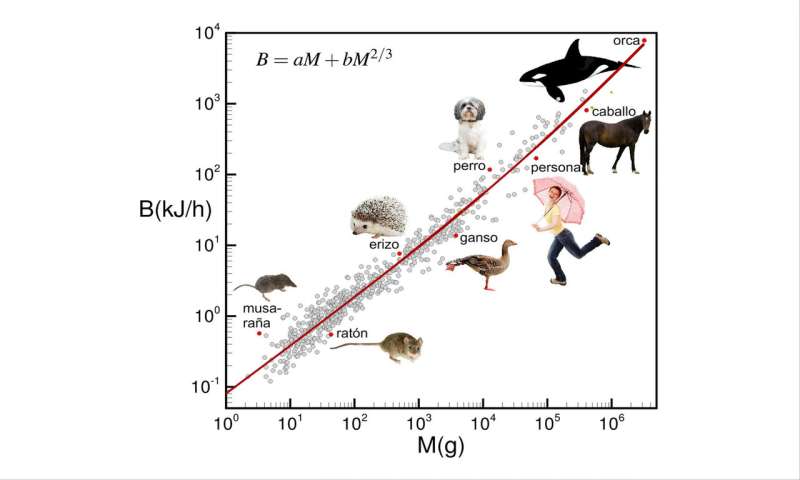Researchers explain why base metabolism varies with mass

A multidisciplinary team of researchers of the Universitat de València, the Universidad Politécnica de Madrid and the Queen Mary University of London has solved a puzzle that bewildered biologists for over a century—how and why an organism's basal metabolism varies depending on its mass. Basal metabolism is the minimum energy that an organism consumes to stay alive. The group's work has been published in Scientific Reports, Nature's open access variant.
An adult human in absolute rest and at a 20º C room temperature burns approximately one calorie per kilo/hour. However, an elephant burns a half-calorie per kilo of mass in the same period, while a mouse burns an astonishing 70 calories per kilo. What causes this difference?
One of the first people to observe this phenomenon was German physiologist Max Rubner, who was studying the basal metabolism of dogs of various sizes in 1883. Rubner suggested that the phenomenon was caused by the heat lost through the skin. The surface area of the skin varies according to the size of the animal squared, whereas its volume varies by the size cubed, which would imply that basal metabolism B varies proportionately to the mass raised to the power of 2/3, M2/3. However, in 1932, measurements that Swiss biologist Max Kleiber performed for mammals of a larger range of masses, including oxen and rats, seemed to indicate that changes in metabolism followed M3/4, a figure we now know as Kleiber's law.
The search for an explanation ignited intense debate over decades, which was seemingly resolved in 1997 with the fractal model of physicist Geoffrey West et al. This model explained the exponent with the fractal form of the organism's networks of resource distribution, such as the circulatory or respiratory systems. Measuring an organism's basal figure is a delicate and laborious task. As the number of metabolic measurements increased by performing measurements on more animals, the fractal model started to show increasing inconsistencies, to the point that in some groups of animals such as small birds or insects, the 3/4 exponent does not fit. Even for mammals, for which Kleiber's law was conceived, data shows noticeable divergence compared to the theory behind the law.
Now, the authors of an article recently published in Scientific Reports have found an unexpected answer via an astrophysics theoretical model. "While we were writing the "Fractales y caos' book, in which we talk about Kleyber's law, we realized that West's fractal model didn't fit. The thermal explanation seemed more natural, but the energetic part that doesn't dissipate like heat had to be taken into account," explains Fernando Ballesteros. "Vicent and I added this to the thermal method, and we saw that the data fit perfectly with our theory. Andrés immediately realized that our model was a trade-off, an evolutionary exchange, and we perfected it together. Enric gave the thermal method solidity after the trade-off, and Bartolo and Lucas expanded the work to living beings other than mammals, confirming its predictive power."
The scientists propose this solution as a compromise between passive caloric dissipation and the minimum energy consumption for cellular maintenance. Not all energy that an organism consumes is transformed into heat; some is used for cell division, some to synthesize proteins—in other words, to support the organism and allow it to work. If all energy was transformed into heat, consumption would be equal to a 2/3 power, but this is more similar to a heater than an organism. On the other hand, if all energy was consumed efficiently, consumption would be directly proportional to the number of cells, that is to say, mass M—but part of it is inevitably lost as heat. Real organisms balance both extremes. The weighted sum of both components, one proportional to mass M and another to M2/3—in other words, B = aM + bM2/3—explains the curve observed in the basal metabolism of mammals and the different relations found amongst different animal groups, but also the metabolic differences between desert and polar animals, or even for plant metabolism.
More information: Fernando J. Ballesteros et al. On the thermodynamic origin of metabolic scaling, Scientific Reports (2018). DOI: 10.1038/s41598-018-19853-6



















